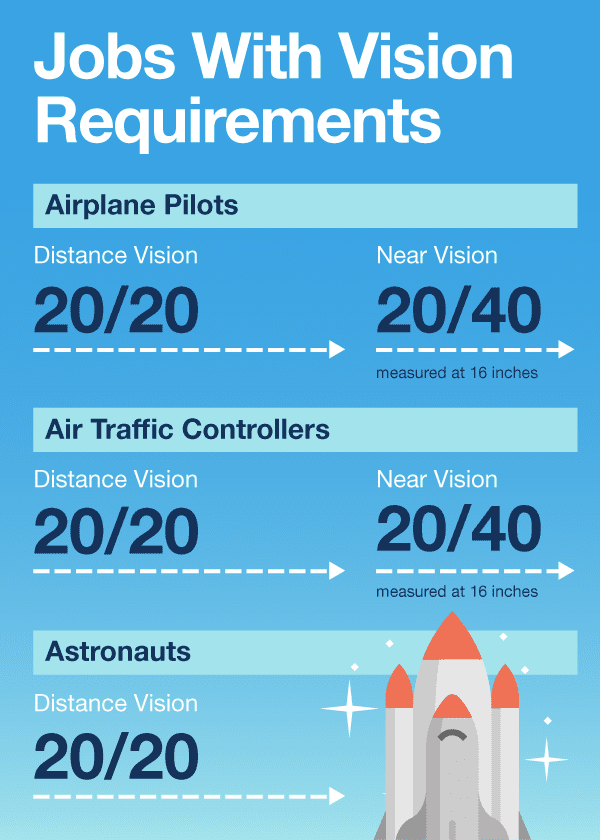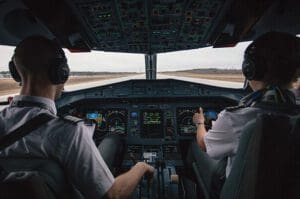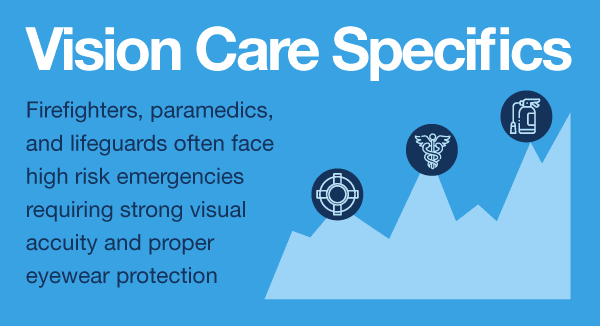Some jobs require perfect vision, but there are many definitions of this term, including full color vision, 20/20 visual acuity, or a certain range of peripheral vision. Many jobs have industry standards from safety organizations and the government. Employees are measured and certified that they meet these requirements. Other jobs are visually demanding, but they have no specific industry requirements.
No matter what you do for a living, your eyes’ health is important. Following specific steps can help you to keep your eyesight clear and healthy for as long as possible.
Jobs With Specific Vision Requirements & Care
You may have heard that some jobs require “perfect vision” for strict safety reasons. While this is true for some of the most demanding jobs, what does “perfect vision” mean?
Most people think of perfect sight as being 20/20 vision, but this number is only the standard for visual clarity. It means you do not have any measurable refractive error like myopia, hyperopia, or astigmatism.
There are numerous other components to good vision, including clear central vision without spots from cataracts or glaucoma, and good peripheral vision, without damage to the retina leading to tunnel vision.
Working in a job with the potential for eye strain, low-light issues, direct sunlight and ultraviolet (UV) exposure, or exposure to toxic substances or chemicals means you must wear safety gear on the job to protect your sight. This ranges from blue-light-filtering glasses to UV-protecting sunglasses to safety goggles.
Many jobs demand good vision, but these requirements vary a great deal based on what you use your eyesight for. For example, some jobs require full color vision, while others require only good contrast sensitivity. Some are physically demanding, so you must have fast reaction times to changes you see, while others require studiousness and good depth perception.
No matter what you do, you should take care of your eyesight. If you work in a job with specific vision demands, understanding these can help you best keep your eyes healthy while maintaining good safety practices.

Types of Jobs With Vision Requirements & Care Specifics
There are many different types of jobs that require good eyesight.
- Airplane pilots: Commercial airlines and U.S. Air Force pilots both need perfect vision. Pilot jobs for major airlines, cargo planes, and military aircraft are extremely demanding positions with long hours and high levels of stress. Airline passengers, shipping companies, and other members of the U.S. Armed Forces trust their lives to pilots in various capacities. Having great reaction times, excellent visual clarity, and strong hand-eye coordination are all vital skills.For non-military pilots, the Federal Aviation Administration (FAA) has strict vision standards. Pilots must demonstrate:
- 20/20 distance vision, which can be corrected with glasses or contact lenses if needed, to hold a first-class or second-class medical certificate.
- 20/40 visual acuity for near vision, which is measured at 16 inches.
There is no intermediate vision standard.
Pilots who are nearsighted (myopia) are required to wear corrective lenses at all times while flying. Pilots who are farsighted — either hyperopic or presbyopic (age-related) — must have corrective lenses available, but they are not required to constantly wear them.
Pilots who are 50 or older can have standard vision at 20/40 when measured from 32 inches, rather than 16 inches. However, this only allows for a third-class medical certificate.
Older pilots may develop cataracts. They are allowed to recertify for flying after cataract surgery and verification that the artificial lens corrects the treated eye to 20/20 vision.

If a pilot is being treated for glaucoma, this does not automatically disqualify them from flying. However, the pilot must present their current intraocular pressure, demonstrate that the condition is stable with treatment, and provide a treatment plan.
Some visual field defects are waivable for pilots. As LASIK and related refractive surgeries become more common, pilots can get LASIK and return to work as long as they receive good results, tested by an FAA-certified optician.
Mono vision contact lenses (MVCL) are prohibited, as focusing one eye on near vision and one eye on distance does not allow for depth perception, which is a vital component of flying safely. However, newer multifocal contact lenses, which improve distance vision in the center and near vision at the periphery, are approved by the FAA. Pilots using these lenses must wear them for one month before returning to flying.
Pilots who are colorblind cannot fly. The use of X-Chrome lenses for colorblindness are prohibited.
- Air traffic controllers: Although much of an air traffic controller’s job involves computer screens, people working in this position need good near vision for these tasks, along with a great far vision to spot airplanes as they arrive and land. Being able to judge distances, distinguish objects at different distances, and react quickly are all vision-related skills required of this demanding job. Like pilots, the FAA has strict vision standards for air traffic controllers. Per the FAA Order 3930.3B, vision requirements for an air traffic controller (ATC) are similar to pilots’ requirements. Controllers must demonstrate 20/20 vision in each eye, independently and together, for distance vision; 20/40 for near vision measured at 16 inches; and 20/40 for intermediate vision at 32 inches for ATCs who are 50 or older. Corrective eyewear like glasses and contact lenses are allowed, as is LASIK with a good outcome on the visual exam. Like pilots, controllers who have cataracts can recertify after cataract removal and artificial lens implantation. ATCs with glaucoma can also continue to work if they demonstrate that their intraocular pressure is stable with treatment. However, unilateral visual field defects are not waivable for ATCs as they are for pilots. In rare circumstances, controllers with some visual field defects may be considered for center operations, but this is on a case-by-case basis.MVCL lenses are prohibited, while multifocal lenses can be used. Like pilots, ATCs must not be colorblind and cannot use lenses to correct colorblindness.
- Astronauts: Early astronauts came from the U.S. Armed Forces, especially the Air Force, so they have similarly demanding requirements of their vision. Not only should astronauts have good visual clarity, but they must also have a fast reaction time, good hand-eye coordination, and good depth perception. According to NASA, astronauts must have at least 20/20 vision in each eye, meaning they should have no refractive error. However, modern guidelines allow astronauts to use eyewear like glasses or contact lenses. These devices must correct vision, so you can pass the long-duration astronaut physical.
- Computer programmers and engineers: The stereotype of a person working with computer programming, both hardware, and software, is a person with thick glasses. While refractive errors like nearsightedness and farsightedness are not detrimental to writing computer code or building circuit boards, these positions do require intensive use of the eyes for long hours, which can cause visual strain. Computer engineers and programmers should be able to manage eye strain, have good near vision for small projects, good hand-eye coordination, and good contrast sensitivity.
- Construction and industrial workers: Because these professions require workers to be close to dangerous chemicals, hazardous materials, and heavy machinery, safety gear is a huge part of working in this field. This includes eye safety gear, like goggles or masks, which protect the eyes from injury or exposure. In addition, having great depth perception, contrast sensitivity, reaction times, and hand-eye coordination are important parts of being safe in these physically risky jobs. Many construction and industrial workers wear prescription lenses, so it is important to keep your prescription up to date. It is also important to get glasses that are made from impact-resistant material like polycarbonate. Ask about glasses that fit snugly underneath your other eye gear if you need goggles, helmets, and other safety gear. Some safety goggles can be made with prescription lens inserts.

- Firefighters: There are several safety measures in place to keep firefighters’ bodies safe while they work. This includes eye protection to reduce damage from smoke or chemicals in a fire. Firefighters need good visual acuity, good depth perception, and good reaction times to put out the source of the fire, save lives, and keep others on their team safe. Although there may be some variance in specific requirements on the local level, standard fire captain vision requirements include the following:
- You must have 20/20 visual acuity in each eye, corrected or uncorrected.
- You can have 20/100 uncorrected vision in each eye if it can be corrected with glasses or contact lenses to achieve 20/20 vision.
- If your vision is worse than 20/100 in each eye, you can only use soft contact lenses to correct it.
- You must wear contact lenses for at least 120 days to get used to them before applying for this position.
- You can undergo LASIK to correct your refractive error, but you must spend at least six months healing before applying for this position.
- You cannot be colorblind, and you must pass a color vision test.
- First responders or paramedics: These professionals are first to the scenes of accidents, natural disasters, and other dangerous scenarios. They must find victims and give emergency assistance in situations that may be filled with smoke, chemicals, or poor light. First responders need good visual acuity for near and far sight, as well as solid depth perception, contrast sensitivity, and hand-eye coordination. Common safety equipment for emergency medical services (EMS) personnel includes eyewear. Safety standards recommend removable eye shields for prescription glasses, and goggles are not required. People who have undergone LASIK or who wear contact lenses can wear industry-standard eye shields.
- Lifeguards: Exposure to sand, sun, and salt complicate lifeguards’ jobs, but swimmers rely on people working this job to keep them safe. While lifeguards undergo great physical and safety training, they must also have clear distance and close vision, along with good hand-eye coordination and reaction times. There are some visual acuity requirements for lifeguards, depending on where the lifeguard is certified. A medical study on lifeguard visual acuity recommended at least 6/7 acuity (British Snellen Chart), which equates to about 20/40 visual acuity. This allows the lifeguard to distinguish objects at a distance and up close, so they can quickly respond. Good contrast sensitivity is also important.
- Photographers: While not a life-or-death position, a talented photographer must see their subject clearly so they can capture the image. Contrast sensitivity, hand-eye coordination, and depth perception are all key to this work.
- Police officers: Law enforcement officers need good vision to assess crime scenes or potential crime scenes, both up close and from a distance. While corrective eyewear can work better for police officers than for many other positions on this list, other physical demands of the job mean that people with naturally good vision are better suited to it. Each state, city, or county may have different specific requirements for officers’ vision, but some standard requirements include the following:
- You must have 20/20 visual acuity in each eye, individually and together.
- If your vision is 20/60 uncorrected in either eye, you can use glasses or contact lenses to correct your vision up to 20/20. If your vision is worse than 20/60, the only allowable corrective wear is soft contact lenses.
- If you wear contact lenses, you must have worn then for at least 120 days (four months) prior to applying for the position.
- Refractive surgery like LASIK is permitted, but you must have six months of healing time before applying for this position.
- You must pass a color vision test, and you cannot use color-correcting lenses like X-Chromes.
- Surgeons: Good near vision is a must for surgeons, who work with delicate machines or small instruments for hours. Often, surgery is a matter of life or death. Surgeons must not only follow the plan with precision, but they just also react quickly to any changes they see and stick to a surgical timeline for the patient’s health. This requires good visual acuity, strong hand-eye coordination, and good contrast sensitivity.
- Truck drivers: If you have ever gone on a long road trip, you know that your eyes become fatigued and strained. Stopping regularly to rest your eyes, as well as stretch your legs, is a huge part of long-distance driving. When driving is your job, you are pressured to stay on the road and deliver on time, all the time. Local delivery drivers, postal workers, and long-haul truck drivers all know that staring at the road can cause some eye strain. It is important for drivers to have good visual acuity, good reaction times in case something occurs on the road, solid peripheral vision to keep track of cars or other objects, and good contrast sensitivity to read road signs. Color blindness should not impact too many professional driving positions, but you must be able to demonstrate that you can still understand stoplights and road signs.Commercial truck drivers must get a commercial driving license (CDL). This has very specific visual requirements, which includes the following:
- You must have at least 20/40 vision, which can be corrected with glasses or contact lenses if needed.
- LASIK or other refractive surgeries are okay as long as your eyes have fully healed before taking the CDL test.
- You must have 70 degrees of peripheral vision on each side.
- You must be able to distinguish between red, green, and amber, but this does not have to be true color vision as long as you can demonstrate that you understand them.
- People with monocular vision can pass the CDL test as long as they have good visual health and pass all other parts of the exam.
- If you have an eye injury causing vision loss, this does not automatically disqualify you, but the injury must be documented. You may only qualify to drive within your state, not over state lines.
Recommendations for Vision Care for All Types of Jobs
No matter what you do for a living, taking care of your vision is important. Here are some recommendations from the National Eye Institute (NEI) for maintaining your eyes’ health long term:
- Wear sunglasses outside or while driving. Choose lenses that block 99 to 100 percent of UVA and UVB radiation.
- Wear protective eyewear in jobs that expose you to potential eye injuries through physical labor or toxic substances.
- Rest your eyes if you work on a computer for several hours during the day, using the 20/20/20 rule. Take a break every 20 minutes and look at something 20 feet away for 20 seconds.
- Keep your contact lenses, hands, and lens case free of contamination with regular hygiene.
- Get regular eye exams to measure your refractive error and any potential health issues like glaucoma or cataracts.
Working with your optometrist or ophthalmologist can help you get answers to specific job-related eye health and safety questions. Your eye doctor can also refer you to industry specialists and professional organizations that can guide you to more information about required safety gear, specific eye health tips, and health requirements for certain jobs.
If you notice any sudden change in your vision or if you experience an injury on the job, see an eye doctor immediately. Prompt treatment ensures that your vision and eye health can be best preserved.